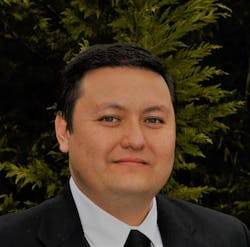How optical wireless communications for enterprises can prevent cyberattacks
While some optimistically predicted that the decades of the 20s would see history repeat itself, it's still too soon to tell whether businesses and economies will roar back from the brink of not only a global pandemic but also monumental cybersecurity breaches. Particularly as employees and communication capabilities become increasingly untethered from a fixed location, businesses across the globe are seeking solutions to bolster resiliency, shore up security and increase speed and bandwidth with the deployment of private 4G and 5G networks.
Unlike a public network hosted by a third party, a private cellular network is hosted on-premises. It doesn't share resources with a third party and only permits access to those devices and users authorized by the organization. Allowing enterprises to determine scale plus the utilized technology and rollout pace, these private networks, with increasing adoption rates, have been deployed by a wide range of organizations to address specific challenges and explore newWhen configuring a private 5G network, spectrum typical comes from three principal ranges:
- Low-frequency bands under 1 GHz
- Mid-frequency bands in the core 3.3 GHz to 3.8 GHz range
- High-frequency mmWave bands in the 26 GHz, 28 GHz and 40 GHz range
Enterprises have three options: licensed spectrum owned by one of the numerous organizations that have purchased Citizens Broadband Radio Service (CBRS), priority access licenses (PALs) in a Federal Communications Commission (FCC) auction or unlicensed band spectrum such as the general authorized access (GAA) tier of the CBRS band.
While each spectrum brings specific advantages, they also come with inherent risks, given that they are easily hackable radio frequency (RF) signals. As 5G becomes more ubiquitous, so too will vulnerabilities. This is primarily due to 5G's heavy reliance on RF, as well as application programming interfaces (APIs) and other supporting service functions. These APIs expose enterprises to API-enabled hacks like the one used to target SolarWinds. With the cleanup from this cyberattack alone potentially costing more than $100 billion in the months ahead, the stakes are extremely high for both economic stability and national security. In addition to thousands of Fortune 500 companies, the Solar Winds hack affected U.S. Departments of Commerce, Treasury, Homeland Security and Justice. Inarguably, current security methods are falling short. Meanwhile, threats to our nation extend to vital areas such as utilities, food, water, oil and gas. Colonial Pipeline may be just the first of what is to come, which is why National Guard simulations are underway to prepare government agencies and industries.
With the critical need to address security and satisfy latency, bandwidth, licensing and cost, companies have explored options, including optical wireless communication (OWC). For decades, NASA used a license-free wireless technology in its Laser Communications Relay Demonstration and the Orion Exploration Mission 2 Optical Communications program; the process uses low-power, eye-safe, infrared lasers in the terahertz spectrum. Ultimately, this OWC technology provides rapid data transmission via beams of light connecting from one telescope to another or point-to-point. Many military applications have relied on OWC for decades to communicate securely over unknown and hostile terrain. Over the years, OWC has benefitted from improvements in lasers, amplifiers and detectors, along with commercial investment from more traditional defense and aerospace companies in the U.S., Japan and Europe.
It's true that OWC, also known as free-space optical communication, is still relatively new in the commercial space, it offers significant benefits over RF. In addition to delivering massive volumes of data at super-fast speeds—20 to 50 Gigabits per user—OWC provides built-in security. Lasers are extremely directional and more precise by nature, allow a very low beam divergence - the chance for data interception is very low compared to traditional RF communications, which broadcasts signals to a large field. When compared to radio photons, the individual photons of an OWC laser beam have much more energy and are so tightly focused that they require much less power than traditional RF to transmit signals yet deliver significantly higher throughputs. The low power transmission enables OWC signals to remain "unseen" from potential threats of detection, thus increasing confidence in securing the wireless transmission.
OWC also offers data encoding in polarization, wavelength-division multiplexing (WDM) and quadrature amplitude modulation (QAM), along with other methods. In some systems, such as Multimedia over Coax Alliance (MoCA), outgoing beams are right-hand circular polarized (RHCP) while incoming beams are left-hand circular polarized. This allows for full bi-directional transmission of data. However, adaptation to this architecture could also enable either higher data throughputs (double the data rate) or the encoding of information (i.e., security keys) into the relationship between the beams to ensure the transmission stream has not been compromised.
In particular, external environments have shown just how effective OWC is at secure data transmission, which is why Starlink uses laser crosslinks to transfer communications from one satellite to another. Now, studies are underway to discover the effectiveness of OWC systems indoors. Barriers to adoption undoubtedly include cost, but with predictions that cybercrime will result in losses in the trillions, it may be well worth the time and investment to fully explore this alternative now.
About the Author

Michael Abad-Santos
senior vice president of business development and strategy at BridgeComm
Michael Abad-Santos is senior vice president of business development and strategy at BridgeComm, bringing more than 20 years of experience in the telecommunications and satellite industries with a focus on the government market sectors, both domestic and international. Prior to BridgeComm, Michael served as chief commercial officer at satellite communications solutions provider Trustcomm, Inc. before joining LeoSat Enterprises as senior vice president, Americas, overseeing commercial activities, strategy development and execution in the Americas region as well as government activities worldwide. In addition to helping secure pre-series A investments of $20 million, he helped secure two strategic investment partners and more than $2B million in pre-launch memorandums of understanding (MOUs) for commercial services. Michael also held various leadership roles at Inmarsat over a 10-year period, including serving as senior vice president of its global government division. A sought-after subject matter expert and speaker, he has presented at industry-leading events including SpaceCom, ITEXPO and MILCOM among others and is a consultant at the Software Engineering Institute at Carnegie Mellon University working with Department of Defense leadership on the intersection of software engineering and space and weapons systems development.


